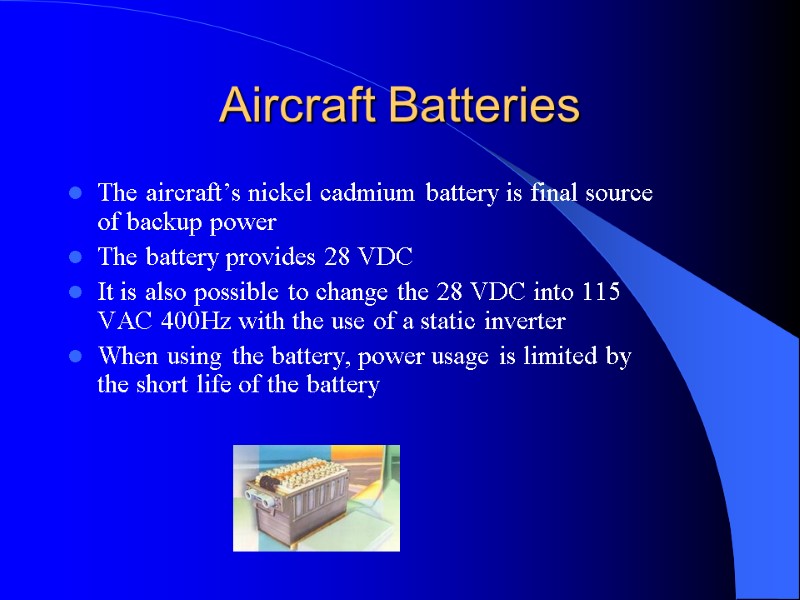Aircraft Electrical Systems By: Borokshinov A.M. Aircraft Electrical


Aircraft Electrical Systems By: Borokshinov A.M.

Aircraft Electrical Systems The function of the aircraft electrical system is to generate, regulate and distribute electrical power throughout the aircraft New-generation aircraft rely heavily on electrical power because of the wide use of electronic flight instrument systems

Electrical Power Uses Aircraft electrical power is used to operate: Aircraft Flight Instruments Essential Systems Passenger Services

Electrical Power Uses (cont.) Essential power is power that the aircraft needs to be able to continue safe operation Passenger services power is the power that used for: Cabin lighting Operation of entertainment systems Preparation of food

Power Used Aircraft electrical components operate on many different voltages both AC and DC However, most of the systems use: 115 VAC @ 400 Hz 28 VDC 26 VAC is also used in some aircraft for lighting

Power Sources There are sever different power sources on large aircraft to be able to handle excessive loads, for redundancy, and for emergency situations. These power sources include: Engine driven AC generators Auxiliary Power Units External power Ram Air Turbines

Engine Driven AC Generators Each of the engines on an aircraft drives an AC generator The power produced by these generators is used in normal flight to supply the entire aircraft with power

APU Power Most often the APUs power is used while the aircraft is on the ground during maintenance or for engine starting However, most aircraft can use the APU while in flight as a backup power source One exception to this is the B272, which only allows APU operation in the ground

External Power External power may only be used with the aircraft on the ground This system utilizes a Ground Power Unit (GPU) to provide AC power through an external plug on the nose of the aircraft GPUs may be either portable or stationary units

Ram Air Turbine Some aircraft are equipped with Ram Air Turbines, or “RATs” These may be used, in the case of a generator or APU failure, as an emergency power source When necessary, the RAT may be deployed to be used as an AC power source

Aircraft Batteries The aircraft’s nickel cadmium battery is final source of backup power The battery provides 28 VDC It is also possible to change the 28 VDC into 115 VAC 400Hz with the use of a static inverter When using the battery, power usage is limited by the short life of the battery

Electrical Power System Components AC Generator Constant Speed Drive Integrated Drive Generator Transformer Rectifier Unit Generator Control Unit

Constant Speed Drive The purpose of the Constant Speed Drive (CSD) is to take rotational power from the engine and, no matter the engine speed, turn the generator at a constant speed This is necessary because the generator output must be 400Hz CSD Operation The engine turns the CSD which uses a differential assembly and hydraulic pumps to turn the generator

Integrated Drive Generator Another method of regulating the generator speed is with the use of an Integrated Drive Generator (IDG) An IDG is simply a CSD and generator combined into one unit There are two ways to mount the IDG: Co-axially Side-by-side

Transformer Rectifier Unit Transformer Rectifier Units (TRUs) are utilized to 115 VAC, 400Hz into 28 VDC A transformer is used to reduce the voltage from 115 volts to 28 volts At this point the 28 volts is still AC current To change the current from AC to DC, a rectifier is used Each aircraft AC bus feeds a TRU which feeds a DC bus

Other Generator Controls and Monitoring Devices A Generator Control Unit (GCU), or voltage regulator, is used to control generator output Generator circuit protection monitors electrical system parameters Voltage Frequency Overcurrent Undercurrent Differential Fault

Other Generator Controls and Monitoring Devices Load controls sense real system load to provide a signal to the CSD for frequency control Current transformers are used for current load sensing and differential fault protection The electrical system control panel may be found either on the pilot’s overhead panel or on the flight engineer’s panel

Function of System Components The basic functions of the electrical system’s components are to: Generate Power Control Electrical Power Protect the Electrical System Distribute Electrical Power Throughout the Aircraft

THE END
9620-aircraft_electrical_systems.ppt
- Количество слайдов: 19

